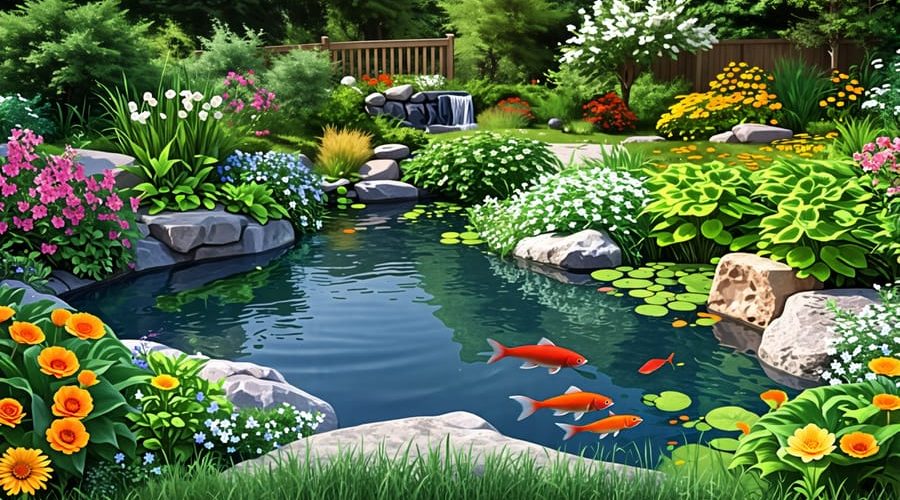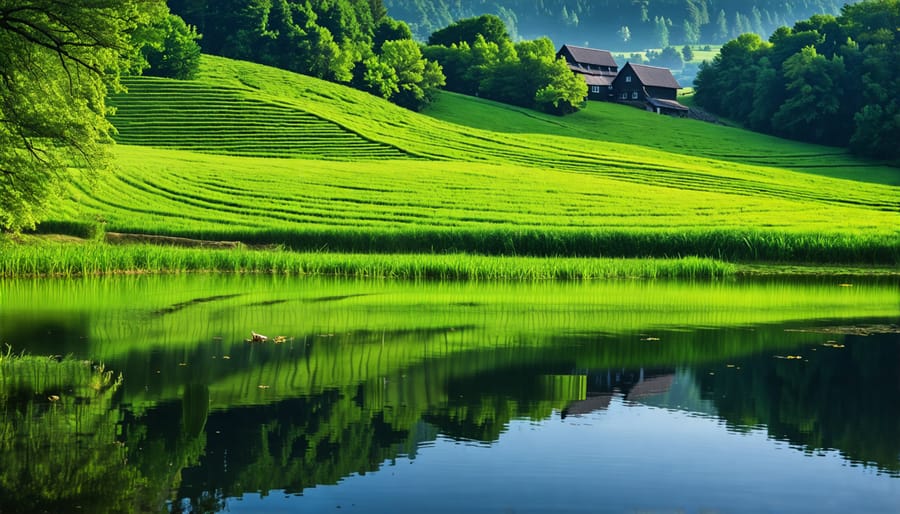
Building Your Dream Farm Pond in 7 Simple Steps
Select the location based on natural drainage and water sources, ensuring accessibility for construction equipment. Excavate the area using appropriate machinery, carving out the pond’s shape and ensuring varying depths for ecosystem diversity. Line the pond with a quality liner to retain water and prevent leakage, tailoring it precisely to the pond’s contours. Fill the pond gradually, monitoring water levels and stability, ensuring there are no leaks or structural issues. Introduce aquatic plants and fish once the water is settled, fostering a balanced ecosystem. Implement regular maintenance, such as checking for algae and monitoring water quality, to preserve the pond’s health. Add personal touches like decorative stones or water features to enhance aesthetics and enjoy the serene beauty of your DIY farm pond.
Step 1: Planning Your Pond

Choosing the Right Location
Choosing the right location for your farm pond is crucial for its success and your enjoyment. Start by observing how sunlight hits different areas on your property. Ideally, the pond should receive ample sunlight for aquatic plants to thrive and prevent excessive algae growth; however, some shade will help maintain cooler water temperatures. Next, pay attention to natural drainage patterns. A spot where rainwater naturally accumulates can effortlessly fill your pond, but ensure it doesn’t receive too much runoff to avoid pollutants. Soil type plays a vital role, too. Clay-rich soil, which retains water well, is perfect for pond construction. Conversely, sandy or gravelly areas may require an additional liner to prevent leakage. By combining these elements thoughtfully, you’ll create a beautiful and efficient farm pond.
Determining Purpose and Size
Before digging your farm pond, think about its main purpose. Do you want to raise fish, attract wildlife, or simply create a stunning backyard feature? Each goal influences the pond’s size. If you’re dreaming of a thriving fish habitat, a larger, deeper pond is ideal, providing ample space and a balanced ecosystem. For attracting wildlife, a moderate size with gently sloping banks works well, inviting ducks or frogs to make a splash. And if the pond is for aesthetic pleasure, let your space guide you—perhaps a small, serene water garden nestled beside a shady tree. Reflect on your aspirations, assess your available land, and adjust the pond’s dimensions to suit your vision and the environment. This thoughtful planning ensures your pond is both practical and picturesque.
Step 2: Designing Your Pond
Designing your pond is an exciting step that allows you to unleash your creativity and tailor the water feature to your landscape. Begin by considering the shape; think beyond traditional circles or ovals. A flowing, organic shape mimics natural water bodies and can easily blend into your surroundings. Sketch your ideas on paper to visualize how it fits with the rest of your garden. You might include curves, coves, or even small inlets to create interest and dimension.
Depth is another crucial consideration that impacts both the pond’s habitat and its visual appeal. For a balanced ecosystem, aim for a depth of at least 2-3 feet at the center. This depth supports aquatic life and helps regulate temperature. If you’re planning on stocking fish, a depth of 4-5 feet is ideal for their habitat. Remember, deeper areas can also add drama and a sense of mystery to your pond.
Take a stroll around your property, studying it from different angles. Visualize how your pond will look from various viewpoints, including any seating areas where you might relax and enjoy the tranquility. Play with different plants and stones around the edges to form a cohesive aesthetic. And if you’re curious about efficient construction methods, they can provide useful insights into realizing your vision with ease.
Step 3: Excavating
Excavating for your pond is a pivotal step where you’ll need to weigh the pros and cons of hiring professionals versus rolling up your sleeves for some DIY digging. Hiring experienced professionals can save you time and energy, ensuring the excavation is done efficiently and correctly. They come equipped with the necessary tools and machinery, and their expertise helps in preventing common pitfalls that could impact the integrity or aesthetic of your pond.
However, if you’re a hands-on DIY enthusiast, excavating your pond can be an immensely rewarding project. It’s crucial to plan meticulously, understand your soil type, and use the right tools to make the process smoother. Renting equipment such as backhoes or mini-excavators can make the job more manageable. Whether you choose to DIY or hire professionals, safety must remain your top priority. Wear appropriate safety gear like gloves, sturdy boots, and helmets. Be mindful of underground utilities—contact local services to ensure it’s safe to dig. Additionally, sloping the sides of the pond appropriately is not just an aesthetic concern—it significantly reduces the risk of collapse, preventing accidents and ensuring your project is sustainable and secure. The joy of seeing your pond take shape with each spadeful or machine scoop is an unbeatable reward that enhances your outdoor space.
Step 4: Installing Liners and Edging
When it comes to installing pond liners and edging, ensuring the longevity and beauty of your pond is key. Begin by carefully spreading your chosen liner across the pond’s foundation. If you’re dealing with a large area, you might need an extra pair of hands to position it properly. Make sure the liner fits smoothly, covering the pond base and extending a little beyond the edges. This overlap helps in securing the liner and prevents any unwanted movement.
Next, pay attention to creating a secure and aesthetic border. You can opt for natural stones or artificial materials, each bringing a unique appeal. Natural stones offer a rustic feel and blend effortlessly with garden landscapes, while artificial options provide more uniformity and require less maintenance.
Gently place your chosen edging onto the liner’s overlap, pressing firmly into the soil to hold it in place. This not only adds structure but also conceals the liner’s edges, enhancing overall aesthetics. While working, if you notice areas where the liner is visible, adjust your stones or edging materials to cover these gaps thoroughly.
Regular checks are important to maintain your pond’s water quality and structural integrity. Over time, you might find slight adjustments are needed to keep things looking pristine and secure. By following these steps, your pond will not only last longer but also be a stunning focal point in your garden. Enjoy the process and let your creativity flow as you mold this serene haven.

Step 5: Adding Water
Filling your pond with water is a rewarding part of the creation process, bringing your hard work to life. Start by selecting a suitable water source; rainwater is an excellent choice as it’s free of chemicals and balances naturally over time. If rain isn’t available, tap water will do, but it might require treatment to remove chlorine and chloramines. As you fill the pond, place a tarp or bucket where the water enters to prevent soil erosion.
Maintaining optimal water quality is key to a thriving ecosystem. Regularly monitor the water’s pH levels, keeping them between 6.5 and 8. Adding beneficial bacteria can also help break down organic matter. Implementing pond aeration keeps water oxygenated and supports pond health. Remember, a well-balanced pond reduces the need for chemical interventions and supports vibrant plant and wildlife, helping you enjoy your picturesque water feature for years to come.
Step 6: Integrating Flora and Fauna

Choosing Plants
Selecting the right plants plays a key role in achieving a picturesque and ecologically balanced farm pond. Choosing a variety of water plants can add beauty and support a thriving underwater ecosystem. Consider adding marginal plants like cattails and irises around the edges for a natural look. These plants not only look attractive but also help in filtering water and providing habitat for wildlife. Floating plants such as water lilies and duckweed add charm and help shade the pond, keeping water temperatures cooler. Meanwhile, submerged plants like hornwort and anacharis release oxygen, crucial for healthy fish and insect life. By choosing a mix of these plants, you’ll ensure your pond is not just stunning to look at, but a flourishing hub of biodiversity.
Incorporating Fish
Introducing fish to your farm pond not only enhances its beauty but also contributes to a thriving aquatic ecosystem. Start by researching species that naturally get along and support ecological balance. Popular choices include largemouth bass, bluegill, and catfish, as they tend to coexist peacefully. Diversifying the fish population helps control insect larvae and promotes water cleanliness. Slowly acclimate fish to your pond by allowing them to adjust in their transport bags floating on the water’s surface for a few hours before release. This step reduces stress and increases survival rates. Remember, overstocking can harm water quality, so opt for a moderate number of fish that your pond can sustain comfortably. Regular observation and maintenance will ensure a healthy environment for your finned friends.
Step 7: Maintenance and Care
Routine care and maintenance are vital for keeping your pond healthy and beautiful year-round. Start by inspecting the water level regularly to ensure it stays consistent. If you notice it dropping, it could indicate a leak that needs immediate attention. One of the easiest ways to maintain your pond’s ecosystem is by checking the filtration system. Clean or replace filters every few months to keep the water clear and free from debris. Algae can be a common issue, especially during the warmer months. Reduce algae growth by using shade plants like water lilies or installing a pond aerator to increase oxygen levels.
In spring, when plants start to grow rapidly, it’s the perfect time to divide and repot any overgrown aquatic plants to prevent overcrowding. Adding beneficial bacteria helps decompose organic material, keeping your pond balanced. During summer, monitor pond life closely. If temperatures soar, add a pond shade or energy-efficient aerator to safeguard your fish and plants.
As autumn rolls in, falling leaves can clutter the water. Skim them regularly with a net or consider installing a pond net. It’s also a great time to perform a deep clean and prune back foliage to prepare for winter. Ensure your pond is well-aerated before the first frost hits, as ice formations can reduce oxygen levels crucial for fish hibernation.
Remember, every pond is unique. Over time, you’ll learn what specific care routines suit your pond’s needs best. With consistent attention and the right seasonal adjustments, your pond can flourish as a beautiful centerpiece in your outdoor space, providing endless enjoyment and satisfaction.
Conclusion
Building your farm pond is a journey filled with rewarding and picturesque outcomes. After following the essential steps—selecting the right location, designing the layout, and implementing proper filtration systems—you will have created a self-sustaining ecosystem that bursts with life. From the tranquil ripple of water under the morning sun to the vibrant colors of fish and aquatic plants, your pond becomes a centerpiece of natural beauty that enhances your outdoor space.
Along the way, you might have experienced challenges like maintaining the perfect water balance or choosing the ideal plant combinations. These hurdles are all part of the gratifying process and add to the unique, personal touch that your pond coalesces over time. Remember, the joy of seeing a dragonfly dart over the surface or hearing frogs croak at dusk evidences the thriving environment you’ve cultivated.
Now, as you sit by your pondside, you can reflect on the transformation—a once empty plot has become a lively, tranquil retreat enjoyed by you, your family, and local wildlife. This is just the beginning; the ongoing process of nurturing your pond ensures that it will continue to flourish, providing endless satisfaction and a peaceful sanctuary in your own backyard.
